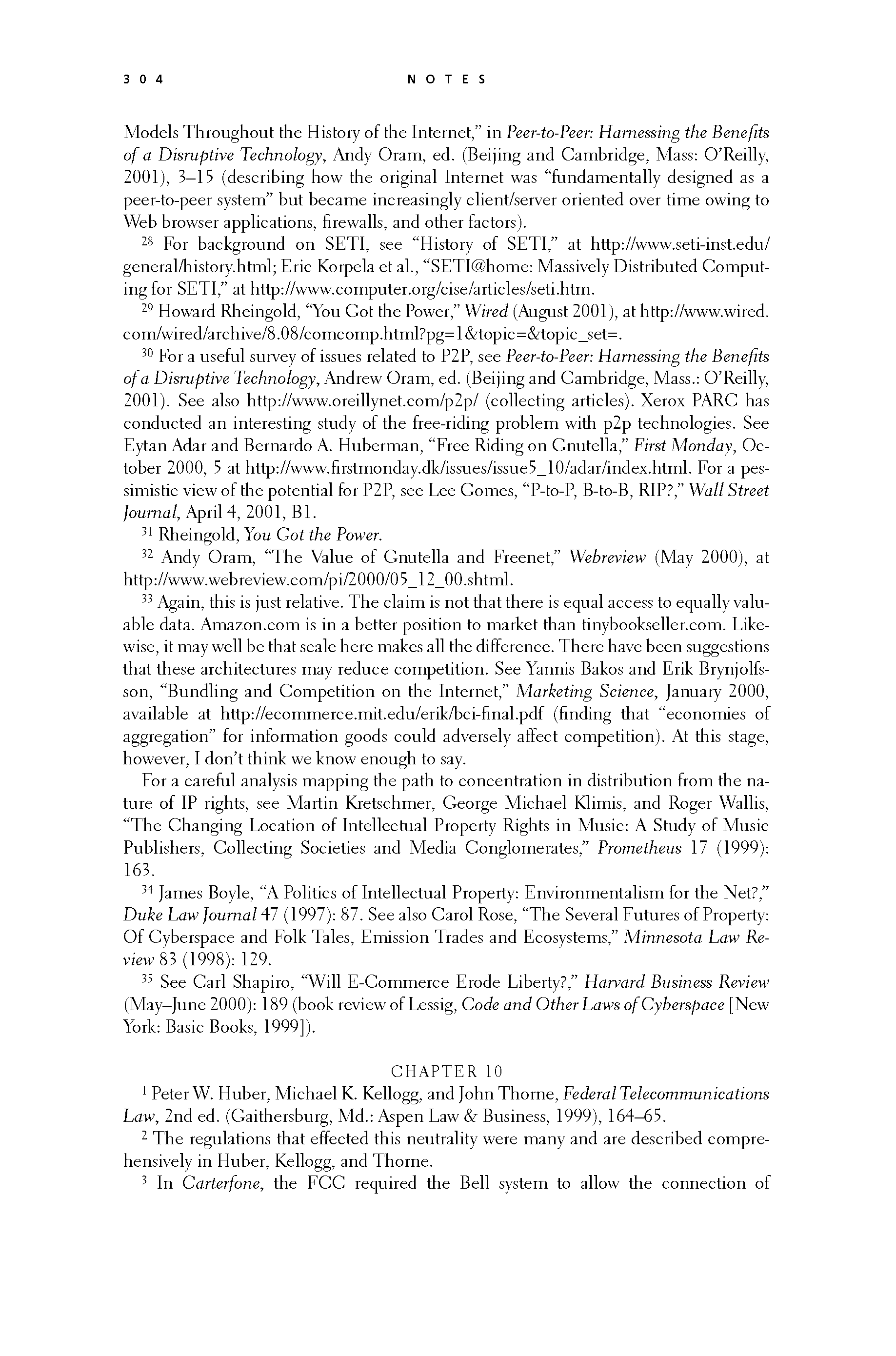 p303 _
-chap- _
toc-1 _
p304w _
toc-2 _
+chap+ _
p305
p303 _
-chap- _
toc-1 _
p304w _
toc-2 _
+chap+ _
p305
Models Throughout the History of the Internet," in _Peer-to-Peer:_Harnessing_the_Benefits_
_of_a_Disruptive_Technology,_ Andy Oram, ed. (Beijing and Cambridge, Mass: O'Reilly,
2001), 3-15 (describing how the original Internet was "fundamentally designed as a
peer-to-peer system" but became increasingly client/server oriented over time owing to
Web browser applications, firewalls, and other factors).
[8-28] For background on SETI, see "History of SETI," at http://www.seti-inst.edu/
general/history.html; Eric Korpela et al., "SETI@home: Massively Distributed Comput-
ing for SETI," at http://www.computer.org/cise/articles/seti.htm.
[8-29] Howard Rheingold, "You Got the Power," _Wired_ (August 2001), at http://www.wired.
com/wired/archive/8.08/comcomp.html?pg=1&topic=&topic_set=.
[8-30] For a useful survey of issues related to P2P, see _Peer-to-Peer:_Harnessing_the_Benefits_
_of_a_Disruptive_Technology,_ Andrew Oram, ed. (Beijing and Cambridge, Mass.: O'Reilly,
2001). See also http://www.oreillynet.com/p2p/ (collecting articles). Xerox PARC has
conducted an interesting study of the free-riding problem with p2p technologies. See
Eytan Adar and Bernardo A. Huberman, "Free Riding on Gnutella," _First_Monday,_ Oc-
tober 2000, 5 at http://www.firstmonday.dk/issues/issue5_10/adar/index.html. For a pes-
simistic view of the potential for P2P, see Lee Gomes, "P-to-P, B-to-B, RIP?," _Wall_Street_
_Journal,_ April 4, 2001, B1.
[8-31] Rheingold, _You_Got_the_Power._
[8-32] Andy Oram, "The Value of Gnutella and Freenet," _Webreview_ (May 2000), at
http://www.webreview.com/pi/2000/05_12_00.shtml.
[8-33] Again, this is just relative. The claim is not that there is equal access to equally valu-
able data. Amazon.com is in a better position to market than tinybookseller.com. Like-
wise, it may well be that scale here makes all the difference. There have been suggestions
that these architectures may reduce competition. See Yannis Bakos and Erik Brynjolfs-
son, "Bundling and Competition on the Internet," _Marketing_Science,_ January 2000,
available at http://ecommerce.mit.edu/erik/bci-final.pdf (finding that "economies of
aggregation" for information goods could adversely affect competition). At this stage,
however, I don't think we know enough to say.
For a careful analysis mapping the path to concentration in distribution from the na-
ture of IP rights, see Martin Kretschmer, George Michael Klimis, and Roger Wallis,
"The Changing Location of Intellectual Property Rights in Music: A Study of Music
Publishers, Collecting Societies and Media Conglomerates," _Prometheus_ 17 (1999):163.
[8-34] James Boyle, "A Politics of Intellectual Property: Environmentalism for the Net?,"
_Duke_Law_Journal_ 47 (1997): 87. See also Carol Rose, "The Several Futures of Property:
Of Cyberspace and Folk Tales, Emission Trades and Ecosystems," _Minnesota_Law_Re-_
_view_ 83 (1998): 129.
[8-35] See Carl Shapiro, "Will E-Commerce Erode Liberty?," _Harvard_Business_Review_
(May-June 2000): 189 (book review of Lessig, _Code_and_Other_Laws_of_Cyberspace_ [New
York: Basic Books, 1999]).
Chapter 10
[10-1] Peter W. Huber, Michael K. Kellogg, and John Thorne, _Federal_Telecommunications_
_Law,_ 2nd ed. (Gaithersburg, Md.: Aspen Law & Business, 1999), 164-165.
[10-2] The regulations that effected this neutrality were many and are described compre-
hensively in Huber, Kellogg, and Thorne.
[10-3] In _Carterfone,_ the FCC required the Bell system to allow the connection of
[[304]]
p303 _
-chap- _
toc-1 _
p304w _
toc-2 _
+chap+ _
p305